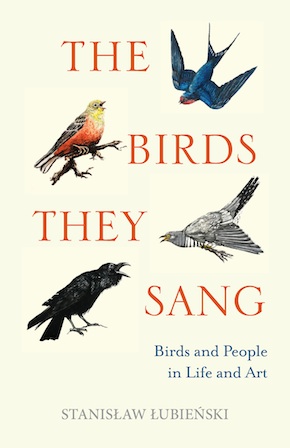Why do birds sing?
by Stanisław ŁubieńskiIt was around midnight when J. and I arrived. The location seemed at first glance unpromising. A snarl of train tracks, interspersed with islands of undergrowth, just outside Warsaw West Station. Neck-high grasses and thistles, less than two miles from the park. It was right here, amid the stink of heated railway sleepers, that a certain unremarkable-looking little bird had decided to stop off on its way north. A birder from Szczecin had been doing some work for Polish Rail in a nearby building. The job dragged on into the night; tired, he decided to take a break. He opened a window and in the stillness heard an unexpected sound.
‘Teeroorooroo-twee-twee’: Blythe’s reed warbler was singing its habitual song. So even here, in this ugliest place in the world, something interesting can come along. Blythe’s reed warbler is a particularly secretive bird that sings almost exclusively at night. For that reason it’s more often heard than seen. By day, what’s more, it’s easily confused with one of its commoner relatives from the reed warbler family. How many Blythe’s fly across Poland unnoticed each year? No one knows. In any case, for this lover of rocky scenery we had to scramble a good way along the embankment. From far off, the Palace of Culture gazed at us through the white eye of its clock. Trains were rattling by inches away; then, when the rumble of the wheels slowly faded, from a dark mass of bushes came: ‘teeroorooroo-twee-twee’.
The first (and so far only) record of a Blythe’s nesting in Poland is from 2011 in Podlasie in the northeast, where it likes to stop during its migration. I go up to the bush, shine my torch on it and, though the bird is probably only a few metres from me, all I can see are leaves and their uncanny shadows. The warbler does not stop singing. Suddenly a small dark shape flits from one branch to another. A moment later the song comes from a different bush. Blythe’s reed warbler likes best of all to live in flooded meadows with stands of willows, from the Baltics all the way to Siberia. It evidently took a liking to Podlasie. Actually, more and more species from the East are appearing regularly in Poland. It’s said that they’re expanding, but I think we’re okay with that kind of expansion.
Right by the Blythe’s, two other birds are transmitting ceaselessly. They are its close relations, marsh warblers, perhaps the most ecstatic avian imitators known to science. They’re capable of singing their crazy improvisations for hours on end, looping their melodies around, abruptly changing tempo and rhythm. According to Françoise Dowsett-Lemaire, who’s conducted research on the subject, marsh warblers have no song of their own whatsoever. Their singing is a brilliant mash-up of sounds they’ve overheard. As David Rothenberg writes in his book Why Birds Sing, the marsh warbler is simply a masterful DJ. I listen to the mad medley. I hear: barn swallow; some unidentified whistlings; greenfinch; mysterious crackles; and something that sounds like a MIDI synthesizer. The unfamiliar sounds are probably voices that the young birds heard during their first winter in East Africa. Singing is all very well, but it seems the females select their mate based on the amount of territory they occupy. So what’s it about? Why do birds sing at all?
Birds, Rothenberg writes, have always sung well; we’re the ones whose tastes are forever changing. What once seemed jarring now sounds different to ears accustomed to free jazz, the twelve-note scale, and scratching.”
There are of course many reasons. Above all, males attract a partner with their song, and inform the competition about the territory they occupy. Throughout the year voices can be heard announcing: ‘I’m here.’ There’s also the universal language of warning. The screech of an alarmed jay is understood by all the animals in the woods. Birds, Rothenberg writes, have always sung well; we’re the ones whose tastes are forever changing. In 1717 came publication of The Bird Fancyer’s Delight, a collection of works that people were to play to their canaries and budgerigars. The idea was to ‘teach them to sing’, to convince them to replace their whistles and chirps with conventional tunes. But today, Rothenberg points out, what once seemed jarring now sounds different to ears accustomed to free jazz, the twelve-note scale, and scratching.
In the 1920s British cellist Beatrice Harrison moved to the country and began practising outdoors in the evening. She heard the local nightingales diffidently joining in during her music-making. After a while they would enter on a full-voiced song whenever she started to play. In 1924, after much persuasion, she convinced Lord Reith, the then director general of the BBC, to broadcast the first music concert recorded in the open air. The crew set up a microphone in front of the bush, while Harrison, dressed in an evening gown, began to play. Whether it was because the birds had stage fright, or they didn’t like the programme, or perhaps the technicians scared them away – in any case, the cello played alone for a good hour. It looked like being a flop.
Fifteen minutes before the end of the broadcast a nightingale added its voice to Dvořák’s Songs My Mother Taught Me. In telling this story, Rothenberg permits himself a touch of scepticism. Was what the listeners experienced not ‘naive anthropomorphism, or a desire to hear music where there was simply sound?’ Perhaps the nightingale had merely been trying to drown out the instrument? Be that as it may, the broadcast was a huge success; Harrison received 50,000 letters of congratulation (!). The cello and nightingale concert was repeated live every year for twelve years. Later the avian singer performed solo, until 1942, when the rumble of approaching bomber squadrons crept into the background. The producer, not wishing to sow panic, cut short the broadcast.
There’s no point in repeating all of Rothenberg’s marvellous book. I’ll summarise just one other charming story featuring the musical genius Wolfgang Amadeus Mozart. According to his expense book, on 27 May 1784 the composer purchased a starling – but not because he was especially fond of birds. This starling sang his Piano Concerto in G major, finished on 12 April that year! How could it have happened since the work had not yet been performed? Coincidence can almost certainly be ruled out. Mozart, who was in the habit of whistling in public, may have slipped the starling the tune. Yet the bird allowed himself a minor adjustment: he changed G to G sharp. In Rothenberg’s view, the arrangement was ahead of its time.
From The Birds They Sang: Birds and People in Life and Art (Westbourne Press, £12.99) © Stanisław Łubieński
 Stanisław Łubieński first began observing birds in childhood through Soviet binoculars. Later, he took his hobby to a more serious level with trips to Hungary, Scandinavia and the Danube Delta. A regular contributor to newspapers and magazines, he is the co-author of a series of films about the life of migrants in Warsaw. The Birds They Sang won the readers’ vote for the Nike Literary award, Poland’s most prestigious literary prize. It is published in hardback and eBook by Westbourne Press, translated by Bill Johnston.
Stanisław Łubieński first began observing birds in childhood through Soviet binoculars. Later, he took his hobby to a more serious level with trips to Hungary, Scandinavia and the Danube Delta. A regular contributor to newspapers and magazines, he is the co-author of a series of films about the life of migrants in Warsaw. The Birds They Sang won the readers’ vote for the Nike Literary award, Poland’s most prestigious literary prize. It is published in hardback and eBook by Westbourne Press, translated by Bill Johnston.
Read more
@SaqiBooks
Author portrait © Albert Zawada
Bill Johnston is Professor of Comparative Literature at the University of Indiana and a prolific translator from Polish. His translations include Stanislaw Lem’s Solaris and The Invincible, Magdalena Tulli’s Dreams and Stories, Moving Parts, Flaw and In Red, and Andrzej Stasiuk’s Nine, Fado and Dukla.



